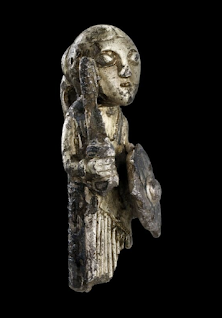English author Mary Ann Evans, who was born on this day in 1819, wrote epic books like Middlemarch (1871) and The Mill on the Floss (1860) under the pen name George Eliot. Literary critic Harold Bloom placed Eliot among the greatest Western writers of all time; Middlemarch has been described as the greatest novel in the English language and Virginia Woolf called it, "one of the few English novels written for grown-up people." Conservative columnist George Will once put the book on a list of ten things he would take with him to another planet, along with Tokin' Woman Susan Sarandon.
Of Will Ladislaw, a character in Middlemarch, Eliot wrote, “The attitudes of receptivity are various, and Will had sincerely tried many of them. He was not excessively fond of wine, but he had several times taken too much, simply as an experiment in that form of ecstasy; he had fasted till he was faint, and then supped on lobster; he had made himself ill with doses of opium. Nothing greatly original had resulted from these measures; and the effects of the opium had convinced him that there was an entire dissimilarity between his constitution and De Quincey's [referring to the author of Confessions of an Opium Eater]."
 In an earlier novel, The Lifted Veil (1859), Eliot writes in first person as Latimer, a man having premonitions of his own death who is "cursed with an exceptional mental character....weary of incessant insight and foresight." A dreamy and sensitive sort of man who is not appreciated by himself or others for these qualities, he writes to the reader, "we have all a chance of meeting with some pity, some tenderness, some charity, when we are dead: it is the living only who cannot be forgiven....while the creative brain can still throb with the sense of injustice, with the yearning for brotherly recognition—make haste—oppress it with your ill-considered judgements, your trivial comparisons, your careless misrepresentations."
In an earlier novel, The Lifted Veil (1859), Eliot writes in first person as Latimer, a man having premonitions of his own death who is "cursed with an exceptional mental character....weary of incessant insight and foresight." A dreamy and sensitive sort of man who is not appreciated by himself or others for these qualities, he writes to the reader, "we have all a chance of meeting with some pity, some tenderness, some charity, when we are dead: it is the living only who cannot be forgiven....while the creative brain can still throb with the sense of injustice, with the yearning for brotherly recognition—make haste—oppress it with your ill-considered judgements, your trivial comparisons, your careless misrepresentations.""And she made me believe that she loved me. Without ever quitting her tone of badinage and playful superiority, she intoxicated me with the sense that I was necessary to her, that she was never at ease, unless I was near her, submitting to her playful tyranny. It costs a woman so little effort to beset us in this way! A half-repressed word, a moment’s unexpected silence, even an easy fit of petulance on our account, will serve us as hashish for a long while."**
 |
| Bronze statue of Eliot in her hometown of Nuneaton in Warwickshire, |
Eliot, who lived with a man out of wedlock, was a radical from an early age. She wrote in an early letter, "May I unceasingly aspire to unclothe all around me of its conventional, human, temporary dress, to look at it in its essence and in its relation to eternity." At the age of 25 she translated David Strauss’s Das Leben Jesu, a book that "deconstructed Christianity as historical myth." Later in life, she corresponded with Harriet Beecher Stowe, author of Uncle Tom's Cabin, and wrote her own anti-slavery novel Romola (1862).
In Middlemarch, the pious Nicholas Bulstrode robs a woman and her son of their inheritance, and kills a blackmailer who knew his past with an overdose of opium and alcohol. When Bulstrode is revealed to be a scoundrel, he protests, calling his accusers those "who have been spending their income on their own sensual enjoyments, while I have been devoting mine to advance the best objects with regard to this life and the next.” Mr. Hawley replies, “As to Christian or unchristian, I repudiate your canting palavering Christianity; and as to the way in which I spend my income, it is not my principle to maintain thieves and cheat offspring of their due inheritance in order to support religion and set myself up as a saintly Killjoy.”
In a second edition published 15 years after The Lifted Veil was first printed, Eliot adds an aphorism to begin the book, perhaps to answer criticism of it:
Give me no light, great Heaven, but such as turns
To energy of human fellowship;
No powers beyond the growing heritage
That makes completer manhood.
I won't ruin the ending of the book, but it has interesting, moralistic twist, as do the works of Eliot's contemporaries Robert Louis Stevenson and Louisa May Alcott.





























